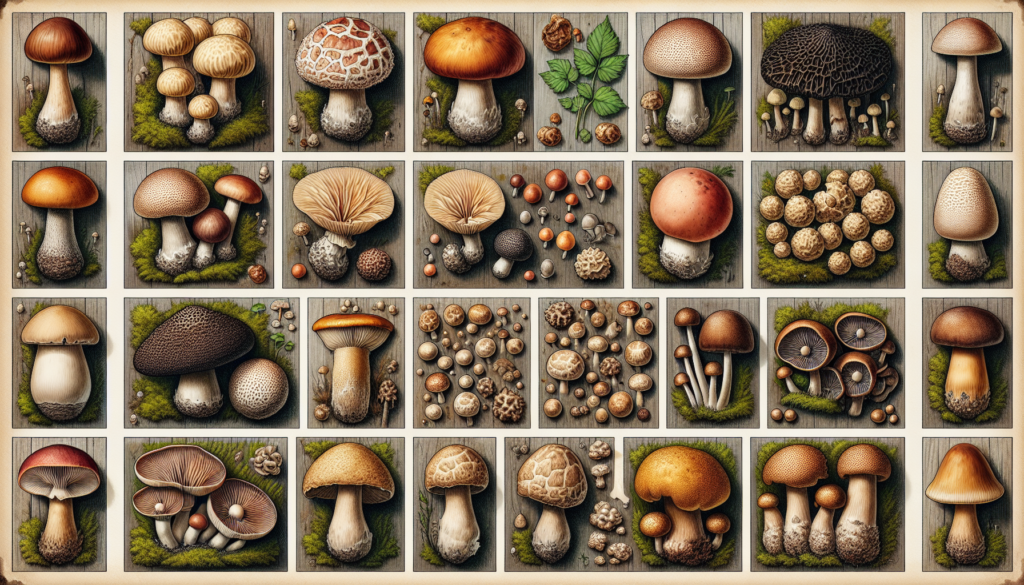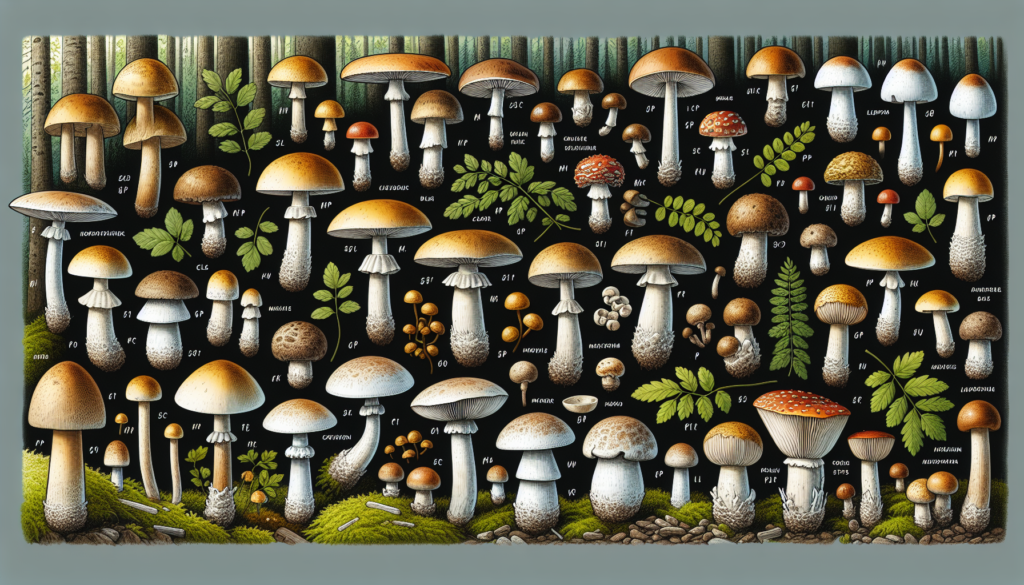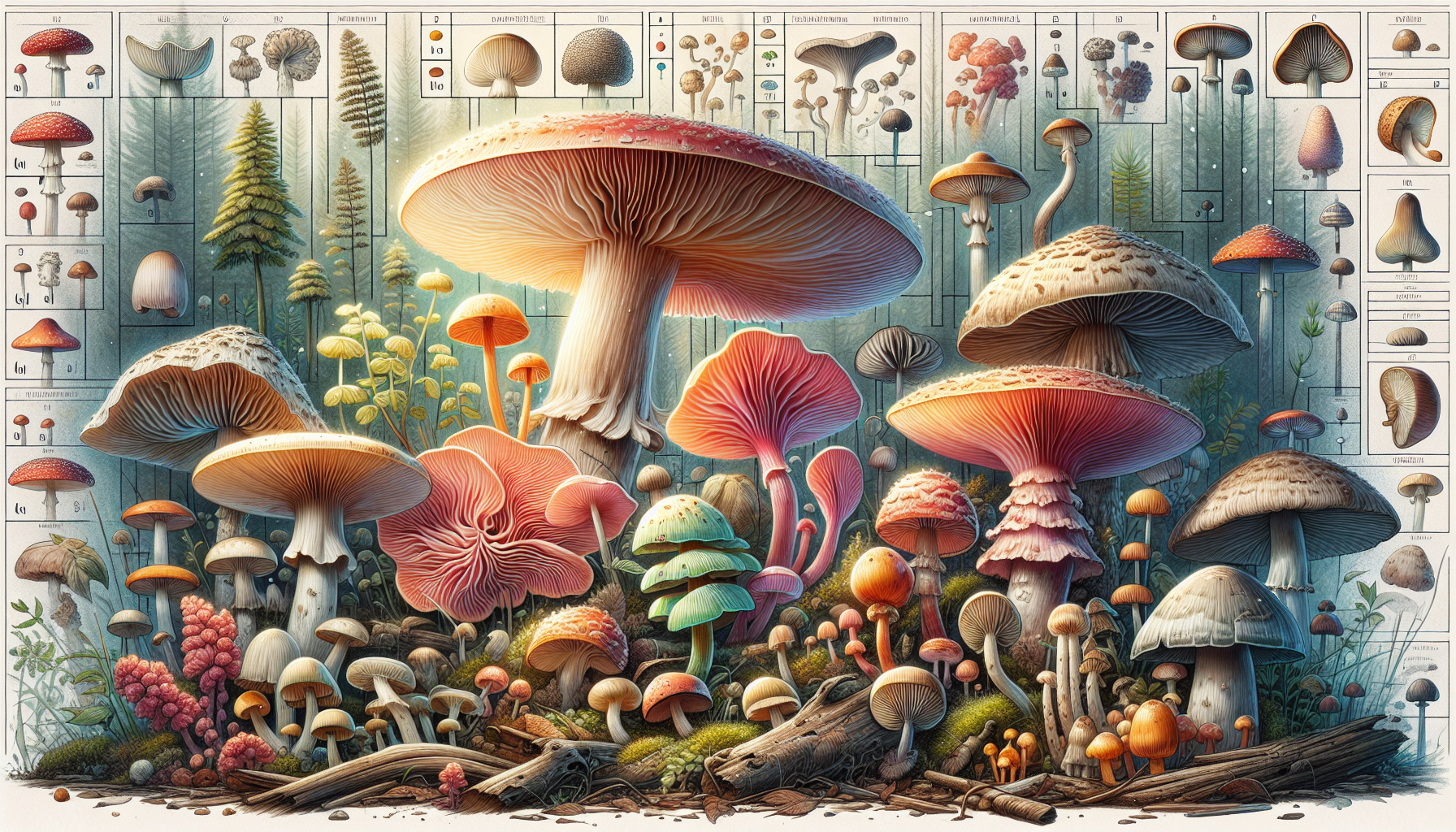Have you ever been on a nature walk and stumbled upon a cluster of mushrooms? Perhaps you’ve wondered if they were safe to touch or even edible. With so many different types of mushrooms out there, it can be difficult to distinguish between the harmless ones and the potentially toxic ones. But fear not! In this article, we will explore the key features to look for when identifying mushrooms. Whether you’re a budding mycologist or simply curious about the world of fungi, this guide will help you navigate the fascinating and sometimes mysterious world of mushrooms with ease. When it comes to identifying mushrooms, there are several key physical characteristics that you should look out for. These characteristics can provide valuable information about the species and help you determine its identity. Let’s explore each of these physical characteristics in detail.
Cap
The cap, also known as the pileus, is the top part of the mushroom that often resembles a curved umbrella. It can vary in shape, ranging from flat to convex or even bell-shaped. The cap can also exhibit different textures, such as smooth, rough, or scaly. Be sure to take note of the color of the cap as well, as it can vary greatly.
Stem
The stem, or stipe, is the vertical structure that connects the cap to the ground. It can be long or short, thick or thin, and may have different shapes, such as cylindrical or bulbous. Pay attention to any distinctive features on the stem, such as rings or an enlarged base. These can be valuable clues in identifying the mushroom.
Gills
Gills, located underneath the cap, are thin, blade-like structures that radiate from the stem’s point of attachment. They play a crucial role in mushroom reproduction by producing and holding the spores. Gills can vary in color, ranging from white and cream to pink, brown, or black. The spacing and attachment of the gills to the stem can also provide important information about the species.
Veil
The veil refers to a thin membrane that covers the gills when the mushroom is young. As the mushroom matures, the veil often breaks or disappears, leaving behind remnants on the cap or stem. These remnants can manifest as rings, scales, or patches and are worth noting in your identification process.
Ring
The ring, also known as an annulus, is a skirt-like structure that may be present on the stem. It can vary in size, thickness, and position along the stem. Some mushrooms have a movable or detachable ring, whereas others have a persistent ring that remains in position even as the mushroom grows.
Volva
The volva is a cup-like or sack-like structure at the base of the stem. It serves as a protective covering for the developing mushroom and can often be found underground. The shape, color, and texture of the volva can provide valuable clues about the mushroom’s identity.
Spore Print
The spore print refers to the color of the spores that are released from the gills. To obtain a spore print, place the cap of the mushroom (gill-side down) on a piece of paper or glass overnight. The color of the spore deposit can range from white or cream to pink, brown, black, or even yellow. This information can be essential in differentiating between closely related species.
Fruiting Body
The fruiting body refers to the visible, reproductive structure of the mushroom. It encompasses the cap, stem, gills, and any other distinctive features. The overall appearance and arrangement of these components can give you important clues about the species you are trying to identify.
Color
Color is a key characteristic to consider when identifying mushrooms. Pay attention to the color of the cap, stem, gills, and any other visible parts. Colors can vary greatly, ranging from white, yellow, orange, red, brown, to black, and everything in between. However, keep in mind that color alone is not sufficient to identify a mushroom accurately.
Texture
Texture plays a vital role in identifying mushrooms. Take note of the surface texture of the cap, stem, and any other visible parts. Mushrooms can have smooth, rough, scaly, or even gelatinous textures. These textures, combined with other physical characteristics, can help narrow down the species.
Now that we have explored the physical characteristics, let’s delve into the ecological factors that can aid in mushroom identification.
Ecological Factors
Habitat
The habitat refers to the specific environment where the mushroom grows. Some mushrooms prefer wooded areas, while others thrive in grasslands, wetlands, or even on decaying organic matter. Understanding the habitat preferences of different mushrooms can guide you towards their correct identification.
Location
Geographical location is another essential factor to consider when identifying mushrooms. Certain species may be endemic to specific regions, while others have a wider distribution. Keep track of where you find mushrooms, as this information can assist in narrowing down their identity.
Growing Season
The growing season refers to the time of year when mushrooms are most likely to appear. Some mushrooms prefer cooler temperatures and are more prevalent in spring or fall, while others can be found year-round. Understanding the growing season of different mushroom species can aid in their identification.
Substrate
The substrate refers to the material on which mushrooms grow. Different species have specific substrate preferences, such as wood, soil, leaf litter, or decaying organic matter. Observing the type of substrate mushrooms are growing on can provide valuable information for their identification.
Moving on, let’s discuss the toxicity levels of mushrooms and how to differentiate between edible, poisonous, and psychoactive species.
Toxicity Levels
Edible
Edible mushrooms are safe to consume and can be a delightful addition to many culinary dishes. However, it is crucial to be absolutely certain of their identity before consuming them. Always consult reliable field guides or seek guidance from experienced mushroom foragers if you plan to eat wild mushrooms.
Poisonous
Poisonous mushrooms can cause a range of adverse symptoms, from digestive issues to organ failure. Some even have deadly toxins that require immediate medical attention. It is essential to be able to differentiate between edible and poisonous species through accurate identification. When in doubt, it is best to err on the side of caution and avoid consuming any mushroom you are uncertain about.
Psychoactive
Psychoactive mushrooms contain compounds that alter perception, mood, and cognition. These species, commonly known as “magic mushrooms,” may have hallucinogenic effects when ingested. While they are not technically poisonous, their use should be approached with caution due to the potential risks involved. It is important to be familiar with the laws and regulations regarding their use in your area.
Next, let’s explore the smell and taste characteristics that can aid in identifying mushrooms.

Smell and Taste
Odor
The odor of a mushroom can range from mild and earthy to pungent or even foul. Some mushrooms have distinctive odors that can be reminiscent of almonds, anise, garlic, or even rotten eggs. Take note of any unique or strong odors as they can provide valuable clues in the identification process.
Taste
Taste is another characteristic to consider, although it is not always safe or advisable to sample mushrooms. Some species may have distinctive tastes, such as sweet, nutty, or bitter. However, keep in mind that taste alone is not a reliable indicator of a mushroom’s identity or toxicity.
Moving on, let’s explore the shape and size characteristics of mushrooms.
Shape and Size
Overall Shape
The overall shape of a mushroom can vary greatly between species. Some mushrooms may have a classic umbrella-like shape, while others can be irregular, lobed, or even coral-like in appearance. Pay attention to the general outline of the mushroom as it can provide valuable information for identification.
Cap Shape
The shape of the cap can vary from flat to convex, bell-shaped, or even irregular. Take note of any distinctive features, such as a central depression or an uplifted margin. These unique cap shapes can help differentiate between different mushroom species.
Stem Shape
The shape of the stem can be cylindrical, club-like, or bulbous. Some stems may be hollow, while others are solid. Pay attention to any unique features, such as an enlarged base or a rooting structure. Stem shape can be an important clue in identifying mushrooms.
Size
Mushrooms come in a wide range of sizes. The cap diameter can vary from just a few millimeters to several inches across. Similarly, the stem length can range from a few centimeters to several feet. Take note of the size of the mushrooms you encounter, as it can be useful in narrowing down their identity.
Now, let’s explore the spore characteristics of mushrooms.

Spore Characteristics
Spore Color
The color of the spores can be an important clue in identifying mushrooms. After obtaining a spore print, observe the color of the spore deposit. Spore colors can range from white, cream, yellow, pink, brown, to black, depending on the species. Comparing the spore color with other physical characteristics can aid in accurate identification.
Spore Shape
Spores can have various shapes, ranging from spherical to elliptical, cylindrical, or even ornamented. Take note of the spore shape when studying mushrooms, as it can help differentiate between species and narrow down your identification.
Spore Size
The size of the spores can vary significantly between mushroom species. Spores can be microscopic, requiring a microscope to observe accurately, or they can be large enough to be visible to the naked eye. Measuring and noting the spore size can be crucial in differentiating between closely related mushrooms.
Moving on, let’s explore the vegetative features of mushrooms.
Vegetative Features
Mycelium Color
The mycelium refers to the underground network of fungal threads that absorbs nutrients and aids in the decomposition process. When mushrooms are not present, you can often observe the color of the mycelium in the surrounding soil or on decaying organic matter. Take note of the mycelium color, as it can provide valuable information about the mushroom species.
Mycelium Texture
Similar to mycelium color, mycelium texture is observed in the absence of the fruiting body. The texture can vary from cottony or fibrous to smooth or web-like. Some mushrooms may have distinctive textures that can aid in their identification.
Mycelium Growth Pattern
The mycelium growth pattern refers to how the fungal threads of the mycelium spread and colonize their surroundings. Some mushrooms have a radial growth pattern, while others exhibit a rhizomorphic or string-like growth. Understanding the growth pattern of the mycelium can provide insight into the species you are trying to identify.
Moving on, let’s consider the associated trees and plants that can indicate the presence of certain mushroom species.

Associated Trees and Plants
Host Trees
Some mushroom species have specific host trees on which they grow. For example, certain mushrooms may have a symbiotic relationship with oak trees, while others prefer birch or pine. Observing the presence of specific tree species can help narrow down the potential identity of the mushrooms growing nearby.
Companion Plants
Certain mushrooms occur in association with other plants, often forming mutually beneficial relationships. For example, some mushrooms are commonly found growing amidst wildflowers or grasses. Pay attention to the presence of companion plants as they can provide valuable clues in mushroom identification.
Indicators of Soil Type
Different mushrooms have specific soil preferences. Some mushrooms thrive in acidic soils, while others prefer alkaline or sandy soils. Pay attention to the soil type and conditions where you encounter mushrooms, as it can assist in their identification.
Next, let’s explore how mushrooms can vary throughout the seasons.
Seasonal Variability
Changes with the Seasons
Mushrooms can exhibit significant changes in appearance and availability throughout the seasons. Some species may fruit exclusively in spring or fall, while others can be found year-round. Observing the changes in mushroom populations as seasons shift can provide valuable information about the species you are trying to identify.
Developmental Stages
Mushrooms go through various developmental stages as they mature. From the initial formation of the fruiting body to its growth and eventual decay, understanding these stages can aid in accurate identification. Take note of the appearance of mushrooms at different stages, including young button forms, open caps, and decomposing or deteriorating specimens.
Lastly, let’s explore some unique visual identifiers that can assist in identifying mushrooms.

Visual Identifiers
Distinctive Markings
Some mushrooms have distinctive markings that can set them apart from others. These markings can manifest as spots, lines, or patterns on the cap, stem, or other parts of the mushroom. Pay attention to any unique markings, as they can be valuable clues in the identification process.
Unique Patterns
Certain mushroom species may exhibit unique patterns that are characteristic of their identity. These patterns can include concentric rings, scales, or even contrasting colors. Take note of any unique patterns you come across, as they can be instrumental in distinguishing between different species.
Peculiar Growth Habit
Some mushrooms have peculiar growth habits that stand out from the norm. This can include mushrooms growing in clusters or in unique shapes and formations. Observing the growth habits of mushrooms can help you identify them more accurately.
In conclusion, identifying mushrooms requires careful observation of their physical characteristics, ecological factors, toxicity levels, smell and taste, shape and size, spore characteristics, vegetative features, associated trees and plants, seasonal variability, visual identifiers, and many other factors. Remember that identification can be challenging and sometimes requires the help of experienced foragers or mycologists. Always exercise caution when handling mushrooms, as some species can be toxic or even deadly. With knowledge and practice, you can develop your skills in mushroom identification and explore the fascinating world of fungi. Happy mushroom hunting!



No Responses